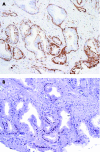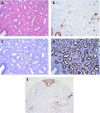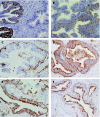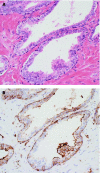Comparison of annexin II, p63 and alpha-methylacyl-CoA racemase immunoreactivity in prostatic tissue: a tissue microarray study
- PMID: 16916997
- PMCID: PMC1995785
- DOI: 10.1136/jcp.2006.040808
Comparison of annexin II, p63 and alpha-methylacyl-CoA racemase immunoreactivity in prostatic tissue: a tissue microarray study
Abstract
Background: Current ancillary markers for diagnosis in prostate biopsies include p63 and alpha-methylacyl-CoA racemase (AMACR). Annexin II (ANXII), a calcium and phospholipid binding protein, is lost in prostate cancer.
Aims: To investigate ANXII expression in order to assess its utility as a novel diagnostic marker in comparison to p63 and AMACR.
Methods: Using immunohistochemistry on six tissue microarrays, ANXII, p63, and AMACR expression was analysed from 210 radical prostatectomy cases. Staining was evaluated in benign and atrophic glands, high-grade prostatic intraepithelial neoplasia (HGPIN), and prostatic adenocarcinoma. Separate scores were given for ANXII, AMACR and p63 expression.
Results: Diffuse cytoplasmic expression of ANXII correlated with p63 reactivity in basal cells. Benign glands were positive for ANXII in 286/292 cores (98%) and negative for AMACR in all 292 cores. HGPIN showed heterogeneous expression of AMACR and ANXII. A significantly larger proportion of HGPIN glands were correctly identified as ANXII negative than as positive for AMACR. ANXII loss in prostate cancer was found in 282/320 cores (88%) and correlated with positive AMACR expression (272/320 cores, 85%), which was not statistically significant. There was no statistically significant correlation between ANXII scores and the clinical parameters examined.
Conclusions: Immunohistochemical staining for ANXII is a consistent and reliable marker of prostatic neoplasia. The findings of this study suggest the potential utility of ANXII as a diagnostic aid in prostate cancer histopathology.
Conflict of interest statement
Competing interests: None.
Similar articles
-
Alpha-methylacyl-CoA racemase (AMACR) expression in normal prostatic glands and high-grade prostatic intraepithelial neoplasia (HGPIN): association with diagnosis of prostate cancer.Prostate. 2005 Jun 1;63(4):341-6. doi: 10.1002/pros.20196. Prostate. 2005. PMID: 15602744
-
Alpha-methylacyl-CoA racemase (P504S)/34betaE12/p63 triple cocktail stain in prostatic adenocarcinoma after hormonal therapy.Hum Pathol. 2007 Feb;38(2):332-41. doi: 10.1016/j.humpath.2006.08.016. Epub 2006 Nov 28. Hum Pathol. 2007. PMID: 17134736
-
Prognostic significance of alpha-methylacyl-coA racemase among men with high grade prostatic intraepithelial neoplasia in prostate biopsies.J Urol. 2008 May;179(5):1751-5; discussion 1755. doi: 10.1016/j.juro.2008.01.012. Epub 2008 Mar 17. J Urol. 2008. PMID: 18343427
-
Application of alpha-methylacyl coenzyme A racemase immunohistochemistry in the diagnosis of prostate cancer: a review.Anal Quant Cytol Histol. 2006 Feb;28(1):1-13. Anal Quant Cytol Histol. 2006. PMID: 16566275 Review.
-
Discovery and clinical application of a novel prostate cancer marker: alpha-methylacyl CoA racemase (P504S).Am J Clin Pathol. 2004 Aug;122(2):275-89. doi: 10.1309/EJUY-UQPE-X1MG-68MK. Am J Clin Pathol. 2004. PMID: 15323145 Review.
Cited by
-
Cancer biomarker discovery: the entropic hallmark.PLoS One. 2010 Aug 18;5(8):e12262. doi: 10.1371/journal.pone.0012262. PLoS One. 2010. PMID: 20805891 Free PMC article.
-
Prognostic features of Annexin A2 expression in prostate cancer.Pathology. 2021 Feb;53(2):205-213. doi: 10.1016/j.pathol.2020.07.006. Epub 2020 Sep 20. Pathology. 2021. PMID: 32967771 Free PMC article.
-
AMACR is a highly sensitive and specific immunohistochemical marker for diagnosing prostate cancer on biopsy: a systematic review and meta-analysis.J Pathol Transl Med. 2025 Jul;59(4):235-248. doi: 10.4132/jptm.2025.04.16. Epub 2025 Jul 3. J Pathol Transl Med. 2025. PMID: 40605376 Free PMC article.
-
ERG oncoprotein inhibits ANXA2 expression and function in prostate cancer.Mol Cancer Res. 2015 Feb;13(2):368-79. doi: 10.1158/1541-7786.MCR-14-0275-T. Epub 2014 Oct 24. Mol Cancer Res. 2015. PMID: 25344575 Free PMC article.
-
The association of annexin A2 and cancers.Clin Transl Oncol. 2012 Sep;14(9):634-40. doi: 10.1007/s12094-012-0855-6. Epub 2012 Jul 24. Clin Transl Oncol. 2012. PMID: 22855149
References
-
- Srigley J R. Benign mimickers of prostatic adenocarcinoma. Mod Pathol 200417328–348. - PubMed
-
- Varma M, Jasani B. Diagnostic utility of immunohistochemistry in morphologically difficult prostate cancer: review of current literature. Histopathology 2005471–16. - PubMed
-
- Schmitz W, Fingerhut R, Conzelmann E. Purification and properties of an alpha‐methylacyl‐CoA racemase from rat liver. Eur J Biochem 1994222313–323. - PubMed
Publication types
MeSH terms
Substances
LinkOut - more resources
Full Text Sources
Medical






